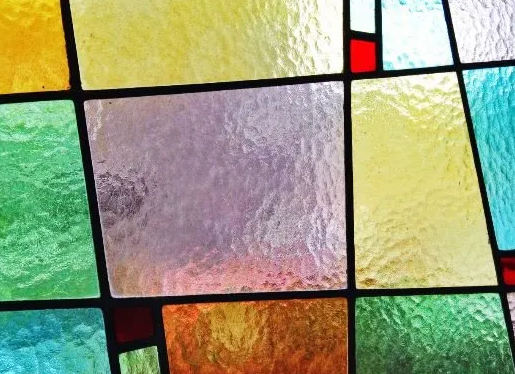
Stained Glass Types explained:
Stained glass encompasses a variety of techniques and styles that go beyond simple colored glass. Here are some of the main categories and types:
Based on Transparency and Effect
- Cathedral Glass: This is a transparent type of stained glass, allowing you to see through it. It comes in a wide array of colors.
- Opalescent Glass: In contrast to cathedral glass, opalescent glass is semi-opaque or milky, diffusing the light rather than allowing clear visibility.
- Opaque Glass: This type of glass transmits very little light, creating a more solid barrier. It can be a single color or a mix of colors.
- Streaky Glass: Features swirls of two or more colors that are mixed but not completely blended.
- Wispy Glass: A combination of transparent and opalescent glass, often used to create cloud effects in stained glass panels.
- Iridescent Glass: Has a thin layer of metallic salts applied to the surface during manufacturing, creating a shimmering, iridescent effect when light hits it.
- Mirror Glass: Colored art glass or clear float glass coated with a reflective layer on the back, making it opaque.
Based on Manufacturing and Texture
- Full-Antique Glass: Handcrafted and mouth-blown using a traditional cylinder method. It's known for its rich colors, linear striations, translucency, and small air bubbles (seeds).
- Flashed Glass: This antique glass has a second layer of color over a base color. This top layer can be partially removed through etching or sandblasting to create designs.
- Craquel Glass: A type of full-antique glass that is intentionally cracked on the surface by dipping it in cool water, creating an alligator-skin texture.
- Fractures and Streamers (Confetti Glass): Made by adding shards of colored glass and thin glass rods to a clear or opalescent base sheet.
- Glue Chip Glass: Created by applying animal hide glue to a sandblasted side of cathedral glass. As the glue dries, it pulls away flakes of glass, forming a fern-like pattern.
- Ring Mottled Glass: Hand-cast opalescent glass with a hazy surface and small circular patterns within the glass.
- Seedy Glass: Cathedral glass with a smooth surface containing small air bubbles (seeds) throughout.
- Waterglass: A common surface texture resembling the ripples of water in a light breeze.
- Rough Rolled Glass: A slight texture added to the surface during the manufacturing process, commonly used on cathedral glass to provide more dimension.
- Textured Glass: Includes various textures like ripple, hammered, granite, crystal ice, herringbone, ribbed, fibroid, moss, flemish, muffle, and cube textures, adding depth and visual interest.
- Drapery Glass: This specific type of stained glass is folded repeatedly while in a fluid state to create depth and resemble the folds of fabric.
Decorative Elements
- Beveled Glass: Features an angled border ground and polished on the edges of clear glass, creating a refractive effect.
- Jewels: Small, faceted, or pressed glass pieces in various geometric shapes, often incorporated into leaded glass artwork.
- Glass Nuggets (Globs): Small, irregularly shaped and sized pieces of glass.
- Rondels: Translucent, circular pieces of glass made by spinning molten glass.
These different types of stained glass, when combined with various construction methods like lead came or copper foil techniques, and painted details, contribute to the vast artistic possibilities of stained glass art.